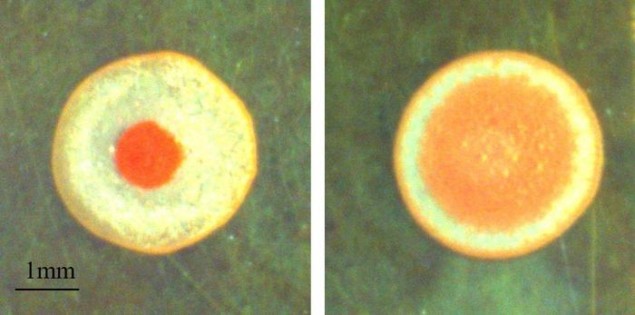Watching paint dry, swimming drag, iconic paper centenary
29 Sep 2023 Michael Banks
Wait for it: as paint drops dry, they can look like a “fried egg” (left) or develop a more even pigment distribution (right). (Courtesy: Adapted from Langmuir 2023, DOI: 10.1021/acs.langmuir.3c01605.)
If you have ever literally watched paint dry then you might have seen a drying drop of paint look somewhat like a fried egg with a yolk of colour surrounded by a pristine white halo. Other drops, meanwhile, might appear uniform in colour when dried.
Paint contains a mixture of substances including resins, pigments, additives and a solvent and because of this complex composition, various interactions are at play when paint drops evaporate.
Researchers from the University of Lyon went about testing this interplay and created five mixtures of a water-based acrylic paint and water and then put some drops onto heated glass slides. They then literally watched as the paint dried.
The team found that pigment concentration and temperature played a key role in how the liquid gelled and evaporated. This then impacted the size, shape and pattern of the dried drops.
Drops with lower pigment concentrations or deposited onto a lower temperature surface led to a “fried egg” appearance while more pigment and higher temperatures led to a more uniform dried pattern.
Optimal swimming
Drafting, or drag reduction, is an important element in races, especially when it comes to cycling where riders can save energy by riding behind a lead cyclist in a peloton. But what about open-water swimming?
To find out, researchers in France carried out experiments and simulations on two swimmer-shaped objects moving at different speeds.
The results showed that swimming directly behind a swimmer can reduce drag by up to 40%. Yet another good position is at the hip of a neighbouring swimmer, which reduces drag by 30% by literally riding the wave created by the other swimmer.
No doubt swimmers will now be buoyed by the opportunity to save some energy during races.
Iconic paper
And finally, Physics World received an e-mail today from Ian Galloway, a physicist in Pontivy, France, informing us that September 2023 marks the centenary of what he calls “one of the most iconic physics papers ever published”.
Galloway is referring to “Ondes et Quanta” by the French physicist Louis de Broglie, in which he proposed that matter is associated with a wave motion, a proposition that he developed more fully for his PhD thesis the following year.
“Wave particle duality was the final part needed for the wave mechanics jigsaw,” Galloway reminds us. “Following Planck’s quanta and Einstein’s work on the photoelectric effect, the wave particle duality set the scene for Schrödinger’s Wave Mechanics, which appeared in 1926. The well known de Broglie relationship λ=h/p ranks with E=hf and E=mc2 and is surely a historical development worth recalling.”
De Broglie went on to win the 1929 Nobel Prize for Physics. But what’s curious is that, as de Broglie himself later knew, most people assumed that it was his PhD thesis, published in 1924, that were the real deal.
In fact, it was three papers in 1923, including “Ondes et Quanta”, which he Broglie presented at a meeting of the Paris Academy of Sciences on 10 September 1923, that really counted for de Broglie in developing wave-particle duality.
Galloway, who is a Fellow of the Institute of Physics, which publishes Physics World, claims that no organisation, not even CERN – the lab de Broglie himself proposed creating in 1949 – made any comment at his death.
“He died largely forgotten and his close involvement laying the building blocks of quantum mechanics seems forgotten also,” Galloway concludes.
Hopefully, we’ve helped remind you at least.

Michael Banks is news editor of Physics World magazine
FROM PHYSICSWORLD.COM 1/102023

Δεν υπάρχουν σχόλια:
Δημοσίευση σχολίου